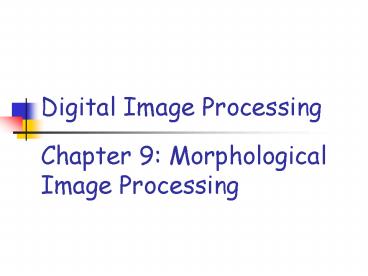Chapter 9: Morphological Image Processing - PowerPoint PPT Presentation
1 / 58
Title:
Chapter 9: Morphological Image Processing
Description:
... element B: all z in A such that B is in A when origin of B=z ... Duality. Opening and closing are dual with respect to complementation and reflection ... – PowerPoint PPT presentation
Number of Views:166
Avg rating:3.0/5.0
Title: Chapter 9: Morphological Image Processing
1
Chapter 9 Morphological Image Processing
Digital Image Processing
2
Mathematic Morphology
- used to extract image components that are useful
in the representation and description of region
shape, such as - boundaries extraction
- skeletons
- convex hull
- morphological filtering
- thinning
- pruning
3
Mathematic Morphology
- mathematical framework used for
- pre-processing
- noise filtering, shape simplification, ...
- enhancing object structure
- skeletonization, convex hull...
- Segmentation
- watershed,
- quantitative description
- area, perimeter, ...
4
Z2 and Z3
- set in mathematic morphology represent objects in
an image - binary image (0 white, 1 black) the element
of the set is the coordinates (x,y) of pixel
belong to the object ? Z2 - gray-scaled image the element of the set is the
coordinates (x,y) of pixel belong to the object
and the gray levels ? Z3
5
Basic Set Theory
6
Reflection and Translation
7
Logic Operations
8
Example
9
Structuring element (SE)
- small set to probe the image under study
- for each SE, define origo
- shape and size must be adapted to geometric
- properties for the objects
10
Basic idea
- in parallel for each pixel in binary image
- check if SE is satisfied
- output pixel is set to 0 or 1 depending on used
operation
11
How to describe SE
- many different ways!
- information needed
- position of origo for SE
- positions of elements belonging to SE
12
Basic morphological operations
- Erosion
- Dilation
- combine to
- Opening object
- Closening background
keep general shape but smooth with respect to
13
Erosion
- Does the structuring element fit the set?
- erosion of a set A by structuring element B all
z in A such that B is in A when origin of Bz - shrink the object
14
Erosion
15
Erosion
16
Erosion
17
Dilation
- Does the structuring element hit the set?
- dilation of a set A by structuring element B all
z in A such that B hits A when origin of Bz - grow the object
18
Dilation
19
Dilation
20
Dilation
B structuring element
21
Dilation Bridging gaps
22
useful
- erosion
- removal of structures of certain shape and size,
given by SE - Dilation
- filling of holes of certain shape and size, given
by SE
23
Combining erosion and dilation
- WANTED
- remove structures / fill holes
- without affecting remaining parts
- SOLUTION
- combine erosion and dilation
- (using same SE)
24
Erosion eliminating irrelevant detail
structuring element B 13x13 pixels of gray
level 1
25
Opening
- erosion followed by dilation, denoted
- eliminates protrusions
- breaks necks
- smoothes contour
26
Opening
27
Opening
28
Opening
29
Closing
- dilation followed by erosion, denoted
- smooth contour
- fuse narrow breaks and long thin gulfs
- eliminate small holes
- fill gaps in the contour
30
Closing
31
Closing
32
Closing
33
Properties
- Opening
- A?B is a subset (subimage) of A
- If C is a subset of D, then C ?B is a subset of
D ?B - (A ?B) ?B A ?B
- Closing
- A is a subset (subimage) of A?B
- If C is a subset of D, then C ?B is a subset of
D ?B - (A ?B) ?B A ?B
- Note repeated openings/closings has no effect!
34
Duality
- Opening and closing are dual with respect to
complementation and reflection
35
(No Transcript)
36
(No Transcript)
37
Useful open close
38
Application filtering
39
Hit-or-Miss Transformation ? (HMT)
- find location of one shape among a set of shapes
template matching - composite SE object part (B1) and background
part (B2) - does B1 fits the object while, simultaneously, B2
misses the object, i.e., fits the background?
40
Hit-or-Miss Transformation
41
Boundary Extraction
42
Example
43
Region Filling
44
Example
45
Extraction of connected components
46
Example
47
Convex hull
- A set A is is said to be convex if the straight
line segment joining any two points in A lies
entirely within A.
48
(No Transcript)
49
Thinning
50
Thickening
51
Skeletons
52
(No Transcript)
53
Pruning
H 3x3 structuring element of 1s
54
(No Transcript)
55
(No Transcript)
56
(No Transcript)
57
(No Transcript)
58
5 basic structuring elements































